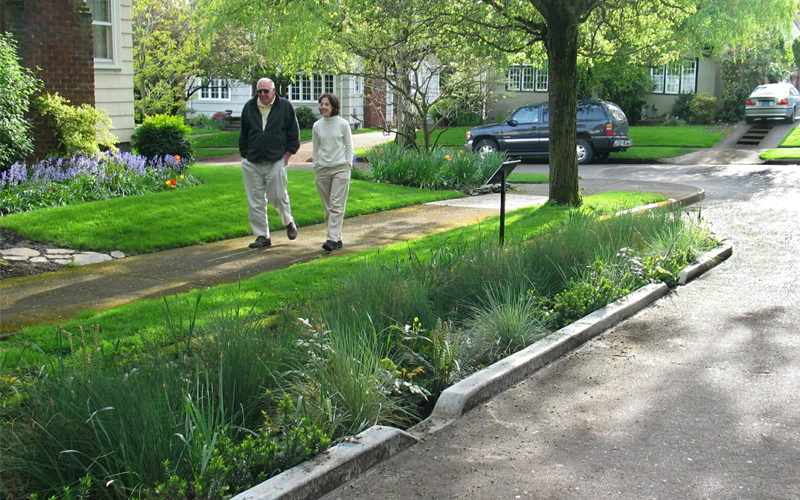Professional Practice
Improving Water Efficiency: Residential Bioswales and Bioretention Ponds
 Stormwater runoff is collected through a series of curb extensions designed to capture and filter stormwater. ASLA 2007 Professional Residential Design Honor Award. NE Siskiyou Green Street, Portland, Oregon / Kevin Robert Perry, ASLA
Stormwater runoff is collected through a series of curb extensions designed to capture and filter stormwater. ASLA 2007 Professional Residential Design Honor Award. NE Siskiyou Green Street, Portland, Oregon / Kevin Robert Perry, ASLA Bioswales and bioretention ponds use plants and soils to infiltrate and treat stormwater runoff. These systems can also dramatically reduce pollutants and contaminants in an effort to increase water quality.
According to the Environmental Protection Agency (EPA), pollution from urban stormwater runoff impairs water quality in approximately 5,000 miles of estuaries, 1.4 million acres of lakes, and 30,000 miles of rivers. The agency estimates that stormwater runoff accounts for 70 percent of water pollution in lakes, rivers, and creeks.
Bioswales, which are wet or dry swales made out of grass, rocks, and other types of vegetation, must be sloped to move water through the system in an efficient manner. Bioretention ponds are depressed vegetated areas that capture and store stormwater runoff and can work in combination with bioswales.
Under federal and state requirements, local governments must implement stormwater management plans and systems. Centralized stormwater management systems are energy-intensive and costly to create and maintain. Local communities can instead invest in decentralized green infrastructure by expanding the use of bioswales and bioretention ponds in residential areas. Bioswales and bioretention ponds not only reduce water flow into overtaxed storm/sewage systems, but also create beautiful amenities.
Local governments can work with planners and landscape architects and designers to develop more sustainable, decentralized stormwater management systems featuring bioswales and bioretention ponds. Homeowner associations and local community groups play a part in maintaining these systems. The NE Siskiyou Green Street project (above) in Portland, Oregon, is an example of this collaboration for better stormwater management through the landscape. The landscape architect, Kevin Robert Perry, ASLA, worked with the city and local community members to replace a parking area on a residential street with stormwater curb extensions, disconnecting the street’s rainwater runoff from Portland’s combined storm/sewage system and managing it through landscape approaches.
Local governments are offering homeowners incentives to create green infrastructure on their properties. In New York City, the department of environmental protection offers a green infrastructure grant that enables communities and organizations to implement more sustainable stormwater strategies. A recent project by the New York Restoration Project, financed by the city, installed stormwater infrastructure capable of capturing 150,000 gallons of stormwater a year at the Gil Hodges Community Garden in Brooklyn’s Gowanus neighborhood. The renovation included bioswales on the adjacent sidewalk that diverts and reuses 65,000 gallons of stormwater a year.
Bioswale/bioretention pond benefits include:
- Reduced runoff: In a typical road, a 4-meter (13-feet) swale can reduce approximately 25 percent of total rainfall runoff.
- Reduced pollutants: Bioswales/bioretention ponds remove pollutants by filtering stormwater runoff through natural vegetation and soil-based systems.
- Recharged groundwater: Instead of releasing stormwater into the drainage system, stormwater can be filtered and may provide some groundwater recharge.
- Improved energy efficiency: Sustainable, decentralized stormwater management systems may be more cost effective than centralized stormwater systems. At the minimum, these natural technologies reduce pressure on existing systems and the maintenance costs associated with centralized stormwater management systems.
Sources: Environmental Assessment, EPA; Bioswales, Capital Regional District, Vancouver; Stormwater Management: Swales, Sustainable Cities Initiative
Organizations
The Low Impact Development Center
National Association of City Transportation Officials
Water Environmental Research Foundation
Resources
Bioswales, Natural Resources Conservation Service, USDA
Best Management Practices Landscape Architects, Water Environmental Research Foundation
Vegetated Swales Fact Sheet, Charles River Watershed Association
Florida Field Guide to Low Impact Development – Bioswales/Vegetated Swales, University of Florida
Bioswales, Milwaukee Metropolitan Sewerage District
Leveraging the Landscape to Manage Water, The DIRT, American Society of Landscape Architecture
Urban Street Stormwater Guide, National Association of City Transport Officials, Island Press, 2017
Government Resources
Stormwater Solutions Handbook, City of Portland
San Francisco Better Streets Plan, San Francisco, California
Stormwater Program, Environmental Protection Agency
New Jersey Stormwater Best Management Practices Manual
SF Green Benefit District, City of San Francisco
Projects
High Point, West Seattle, Washington
Mithun
Street Edge Alternatives Project (SEA Streets), Seattle, Washington
Broadview Green Grid Project, Seattle Washington
110th Cascade Project, Seattle, Washington
NE Siskiyou Green Street, Portland, Oregon
Kevin Robert Perry, ASLA
SW 12th Avenue Green Street Project, Portland, Oregon
City of Portland, Department of Transportation
Sweetwater Spectrum Residential Community for Adults with Austim, Sonoma, California
Roche + Roche Landscape Architecture